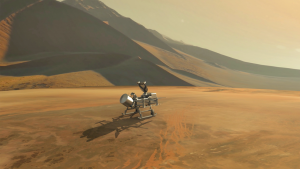Jul 24, 2019 | No Comments | By Michelle Pagano
HEMI Fellow Sarah Hörst (Dept. of Planetary & Earth Sciences) is part of the team leading NASA’s newly-announced Dragonfly mission. Dragonfly is a rotorcraft-lander expedition to the surface of Saturn’s moon, Titan, which is considered to be the most Earth-like world in the solar system. The Johns Hopkins Applied Physics Laboratory is leading the project with a goal to launch Dragonfly in 2026 and land in 2034.

Artist’s Impression: Dragonfly in flight over Titan | Image Credit: Johns Hopkins APL
Over the following 2.7 years, Dragonfly will explore various locations, from organic dunes to the floor of an impact crater, across Titan. During this time, it will take samples of its organic surface materials to measure and characterize the moon’s environment as well as investigate the progression of prebiotic chemistry. The team will also look into Titan’s atmospheric and surface properties, and its subsurface ocean and liquid reservoirs. Click here for more details about the mission and its background.
Fittingly, Professor Hörst’s primary research focus is atmospheric chemistry, with a particular interest in the complex organic chemistry occurring in Titan’s atmosphere. During the summer of 2018, she participated in the HEMI/MICA Extreme Arts Program, through which she mentored MICA student Amy Wetsch. Wetsch used the opportunity to create mixed media sculptures of her vision of Titan’s atmosphere using materials from Hörst’s lab. Read more about Wetsch’s exhibit here.

Through the Veil (Wetsch, 2018)



